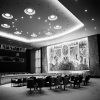
* Original version in Spanish: Ideas locales que viajan en inglés: análisis de redes de think tanks en Twitter.
Summary
This paper analyses the networks of relations between think tanks in order to better understand their nature and the way they operate in a global reality. This exploratory research makes use of data collected on Twitter.
Introduction
What are known as research institutes or think-tanks carry out activities that are sometimes viewed with suspicion by public opinion. At other times, their activities are not fully understood by a part of civil society that fails to comprehend both their nature and the way they operate. This study attempts to shed some light on how think-tanks function worldwide, analysing the factors underlying their relations in a wide-ranging social network such as Twitter.
This paper analyses the networks connecting think-tanks in order to better understand their nature and the way they operate within a social reality. As an exploratory study, it makes use of data collected on Twitter in order to approach the larger phenomenon that is the subject of analysis. It focuses on studying the network of relations involved and on what they tell us about how think-tanks function. Nevertheless, it does not specifically deal with the influence that these institutions exert through Twitter.
Twitter creates networks of people and institutions through which information travels and ideas are easily spread, but the think-tanks’ relationship models in this network diverge from the classic communications standard and modify it for their own ends. Counting how many twitter followers a think-tank has is an insufficient criterion to evaluate its influence since the latter must be assessed on the basis of other variables that relate to the quality of contacts rather than to their number.
For this reason, we are interested in knowing exactly what the relations between international think-tanks are and, above all, how they operate in relation to certain factors involved in the political decision-making process. Thus, a think-tank’s influence is drawn up as a map of relationships represented by graphs. These relationship maps do not focus on the worldwide renown of a particular institution but are based on the intensity of the relations between think-tanks in the network. Thus, if a think-tank wishes to influence decisions in a political process generated within a particular institutional framework it will be easier for it to exert its influence virally through networks that share common goals. This is the reason why a think-tank’s influence map will revolve around a political power hub and will be conditioned by it and by the political decisions taken there.
We define a think-tank as an institution devoted to the analysis of international networks and to researching public policies, whose main goal is to influence the various actors that operate in decision making processes.[1] The term ‘influence’ is related to others used in the analysis of international relations such as ‘presence[2] and ‘power’, but it differs from them in that it needs to create trends through the ideas or ideology.
Think-tanks can be independent or be affiliated to an ideology, political party or power group identified as such, and often bridge the gap between different communities in the academic and political worlds. At the same time they serve the public interest by producing basic research and studies adapted to a form and language accessible to both public opinion and legislators.[3]Furthermore, they shape opinion and provide advice on international issues and public policies. They do so by using different forms of languages[4] and by having among their main goals influencing both policy makers and public opinion –providing that public opinion enjoys a share of power, as it is expected to in a state based on the rule of law and democratic values–[5]This paper’s aim is neither to analyse the origin of the ideas generated within the framework of these institutions nor to scrutinise their financing or their circles of power and presence.
The kind of influence exerted by a think-tank is similar to that of the press; namely, it is regarded influence through mediation.[6] Its power lies in the creation of conceptual frameworks that deal with a topic and in the selection of its content, both when it comes to choosing what topics are to be treated and to what extent they are important, as well as to deciding which data must be shown to be relevant and which are not –a process known as news-framing–.[7]
Although think-tanks tend to get closer to the news-framing process in order to offset the analytic inadequacies of the non-specialised press,[8]there are still differences between the two. The differences lie in the ‘expert’ status of researchers, as against journalistic independence, and in their aims, which focus to a lesser extent on the general public than the media, including specialised publications. Among the sources used to validate ideas, the media are at a stage prior to think-tanks, mainly because the latter’s targets are decision makers and they expect the press to act as a mediator between them and public opinion. Think-tanks that deal with issues related to human rights and that focus on various aspects of human security at times of crisis and conflict are, generally, the exception to the rule. In fact, some believe they should be treated as something completely different.
Juan A. Sánchez
Information specialist and head of the Information and Documentation Service at the Elcano Royal Institute
Juan Pizarro Miranda
Researcher in communication sociology and networks at the Sociology Faculty of the UCM and project consultant at OPTA Consultants
[1] James G. McGann and Erik C. Johnson (2005), “Comparative think tanks, politics and public policy”, Edward Elgar, Cheltenham.
[2] Iliana Olivié and Ignacio Molina (2012), Measuring the international presence of countries: the Elcano Institute’s IEPG Index methodology revisited, Working Paper nº 9/2012, Elcano Royal Institute, Madrid, 20/VII/2012.
[3] T. Medvetz (2008), Think tanks as an emergent field, Social Science Research Council, Nueva York.
[4] Juan Luis Manfredi (2014), “Los cuatro idiomas del think-tank”, Elcano Blog, 24/IX/2014. What we understand as languages are those adapted to the four main audiences of a think-tank: the languages of public policies, of journalists, of the academy and of the digital world.
[5] McGann y Johnson (2005), op. cit.
[6] J.M. Noguera Vivo (2013), “How open are journalists on Twitter?: trends towards the end‐user journalism”, Communication & Society = Comunicación y Sociedad, vol. 26, nº 1, pp. 93‐114. In this regard, Professor Noguera’s research suggests that end-user journalism –focused on the user–, in which non-professionals are more involved and journalist have a greater capacity to select and make decisions, is increasingly prevalent on Twitter..
[7] M. McCombs y D. Shaw (1972), “The agenda-setting function of mass media”, Public Opinion Quarterly, nº 36.
[8] The Economist (2014), “Think-tanks and journalism: making the headlines”, 20/IX/2014.




